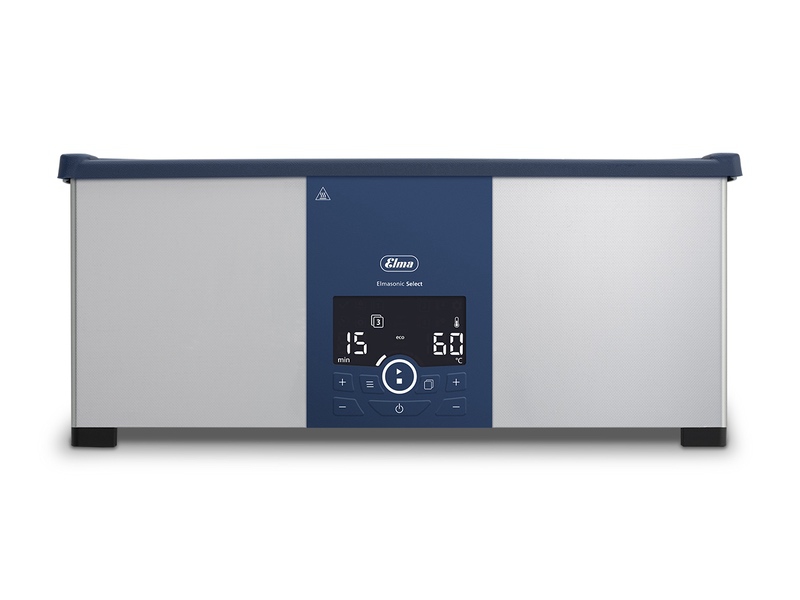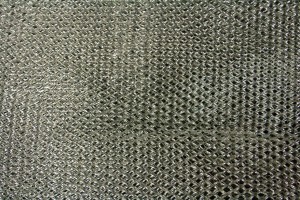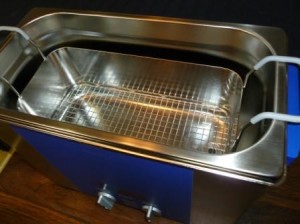Ultrasonic Cleaners
How to Prepare Samples Rapidly and Safely

Sample preparation to transform analytes into measurable form can involve complex processes. It is important that the transformation or extraction process avoids chemical degradation that can be caused by excessive heat or mechanically induced damage.
Ultrasonic energy is a proven technique to achieve fast, safe sample preparation. As an example it is a method often specified in USP monographs to extract active pharmaceutical ingredients from carriers for content uniformity and potency assay tests. The ultrasonic process is also ideal for dissolving, dispersing, emulsifying, homogenizing and mixing.
Sample Preparation Steps
Samples to be analyzed are placed in flasks along with a recommended solvent. Flasks are partially immersed in a sonicator bath containing a surfactant. The 37 kHz Elmasonic S Select 150 ultrasonic bath available from Tovatech is especially designed to quickly and safely accomplish sample preparation. The inside dimensions of the shallow basket, (LxWxH) 17.9 x 9.8 x 2.2 … Read the rest
How to Quickly Clean MX and ATV Bike Engine Parts

Messy, time consuming manual cleaning MX and ATV quad bike engine, drive and suspension parts is unnecessary when an ultrasonic cleaner replaces scrubbing with solvents in wash tanks. Cycle service shops as well as MX and ATV clubs can put the power of ultrasound to work to speed throughput and preserve investments in off-road sports equipment.
Ultrasonically cleaning MX and ATV bike parts is faster than manual methods for two reasons:
- Many components do not have to be completely disassembled, but simply immersed in a biodegradable ultrasonic cleaning solution.
- It is thorough because sonic cleaning action removes road dirt, grease, grime, varnish, carbon deposits and other contaminants. Cleaning reaches the tiniest and most inaccessible grooves and blind holes in engine and suspension components – in short all surfaces immersed in the cleaning solution.
Mighty Bubbles Blast Away the Grime
The thoroughness … Read the rest
Reclaim Industrial Filters in an Ultrasonic Cleaner
Google industrial filters and you’ll get about 12.5 million results. Narrow it down to industrial metal mesh filters and the count is just over 1 million. The point: industrial filters are a big business to trap and hold airborne particles such as dust and grease. Other filters are used to strain impurities from water and chemicals. As with your air conditioner filters and your automobile fuel and oil filters particles build up, flow becomes restricted, and eventually filters must be changed.
Frequent filter replacement represents an expense that can be reduced by reclaiming industrial filters in a sonic cleaner. Reclaiming becomes increasingly attractive as replacement cycles shorten or when filters are expensive. Another benefit of reclaiming is that fewer filters wind up in a landfill.
Why Ultrasonic Filter Cleaning Works Best
High-pressure jets of hot water may be used to … Read the rest
When to Use an Industrial Steam Jet Cleaner
A compact steam jet cleaner can be an excellent solution for chemical-free and environmentally friendly removal of deposits such as oil, lubricants, polishing pastes, waxes, chips and filings from cast, machined and other fabricated parts. High temperatures and pressures produced by an industrial steam cleaner remove contaminants from tight spaces such as threaded blind holes, and precision machined and cut gears faster and more thoroughly than hand cleaning, leaving surfaces residue free. Another benefit of steam cleaning is reduced disposal costs for removed contaminants.
Where higher levels of cleanliness are required a steam jet cleaner can be used to prepare parts for an ultrasonic cleaning cycle. Pre-cleaning parts with steam has the added benefit of reducing contaminant build-up in ultrasonic cleaning solutions.
At the end of the cleaning job the cleaner can be used for rinsing. The advantage is that steam is free of minerals and chemical agents; thus … Read the rest
Ultrasonic Cleaning Systems for Precision Optics
Specifying ultrasonic cleaning systems for precision optics requires close collaboration between optics manufacturers establishing optical cleaning requirements and engineers at firms supplying the equipment and chemicals to fulfill those requirements. It is not the intent of this post to specify cleaning equipment and procedures. Instead it’s our objective to provide an overview of Elmasonic equipment for cleaning ophthalmic optics.
And a wide range of equipment it is – ranging from individual cleaning tanks to fully automated multi-stage wash-rinse-dry cleaning lines in a clean room. We’ll briefly describe cleaning chemicals formulated for specific functions from mold manufacturing to cleaning for inspection and cleaning for coating.
Other equipment supporting cleaning optics includes water treatment plants, filtration systems, solvent treatment plants and laminar air flow modules to support clean rooms.
Our role, other than to provide these introductions to equipment and chemicals, is to put you in touch with equipment specialists for cleaning … Read the rest
Deionized Water Rinsing after Ultrasonic Cleaning
We’ll start this post by stating that it is not always necessary to rinse products after ultrasonic cleaning. Engine parts such as gears and carburetors are examples where cleaning solution residues may be tolerable. If not, then rinsing cleaned parts with fresh water should usually suffice. There are other areas, however, where thorough rinsing is essential and where deionized water rinsing after ultrasonic cleaning is strongly recommended.
These are applications where the slightest bit of remaining contaminants or cleaning solution residues can impact performance. Electronic components such as printed circuit boards, optics, and medical and surgical instruments, are examples. These are applications where spot-free drying is the goal, and in this context “spots” relate to dissolved minerals in regular water that remain as residues when the water evaporates.
Removing dissolved minerals in water is generally accomplished by two methods. Deionization is a process that produces deionized water (DI water) by … Read the rest
Ultrasonic Cleaner Operating Tips
New ultrasonic cleaners are usually shipped with operating instructions. These may be misplaced. If you purchase a used sonic cleaner the manual may not be included. Improperly using this equipment can quickly damage it, which is why we’re presenting this post on ultrasonic cleaner operating tips. They are not in order of importance because all are important.
These tips are not comprehensive but they do cover a majority of cases. If you have questions please contact us whether or not we supplied the unit.
Cleaning Baskets
Parts being cleaned should never be in contact with the ultrasonic cleaner tank. Why? The ultrasonic vibrations caused by transducers mounted to the tank will cause parts to wear against the tank surface. Eventually this may result in a leak. Instead position what you are cleaning in parts baskets that are designed to fit the tank. … Read the rest
Ultrasonic Nanoparticle Dispersion
Sonication in laboratory ultrasonic cleaners is a widely accepted process for the dispersion or separation of nanoparticles in liquids – that is breaking up nanomaterial agglomerates. It is an effective alternative to other dispersion methods such as rotor-stator homogenizers, piston homogenizers and wet milling. A number of factors should be considered when selecting ultrasonic equipment to break up agglomerates whether you use a solvent-based or aqueous suspension.
As an introduction you must keep in mind that the optimum performance settings of the ultrasonic equipment may vary depending on the agglomerates being dispersed. In other words if you are working with a variety of nanoparticles you should investigate equipment with adjustable operating parameters.
Here we provide some guidelines on ultrasonic equipment selection for nanoparticle dispersion.
Ultrasonic power:
In this case power refers to the ultrasonic power input into the bath. In this post we use the 3-quart capacity dual frequency … Read the rest
How to Clean Lab Glassware
Cleaning volumetric lab glassware such as burets, pipettes, flasks, and graduated cylinders can be a daunting task for two reasons: laboratory glassware is susceptible to breakage and associated replacement costs, and complex configurations make thorough cleaning difficult. But all lab personnel know this.
The task is made easier with an ultrasonic cleaner – equipment widely used in labs for a variety of reasons. One of these is being an excellent means to thoroughly remove tenacious contaminants from delicate laboratory glass. The secret to effective sonic cleaning lab glassware is selecting the right cleaner, cleaning solution formulation and establishing a consistent cleaning procedure.
Cleaning is accomplished by cavitation action, the implosion of millions of minute air bubbles created by generator powered transducers bonded to the bottom of the cleaning tank and vibrating at ultrasonic frequencies such as 37,000 cycles per second (37 kHz). The imploding bubbles safely and effectively remove contaminants … Read the rest
Ultrasonic Cleaner Maintenance Tip: Tank Discoloration
A Tovatech customer asked us about the cause and removal of a discoloration inside his Elmasonic ultrasonic cleaning tank. The location and size of the tank discoloration suggested to us that it was caused by the heater. We present here a tip on how to prevent discoloration (sometimes called “furring”) and if it occurs how to remove it.
Furring can show up in a variety of colors in an ultrasonic tank. It can occur if the unit’s heater is activated when the ultrasound is not activated. This causes the solution adjacent to the heater to reach very high temperatures resulting in discoloration. (It’s somewhat like placing an empty stainless steel pot on the stove and turning on the burner. You’ll soon get a discoloration.)
So, even though the tank may be filled, if the solution is not circulating there will be a significant temperature differences that can result in discoloration.… Read the rest


